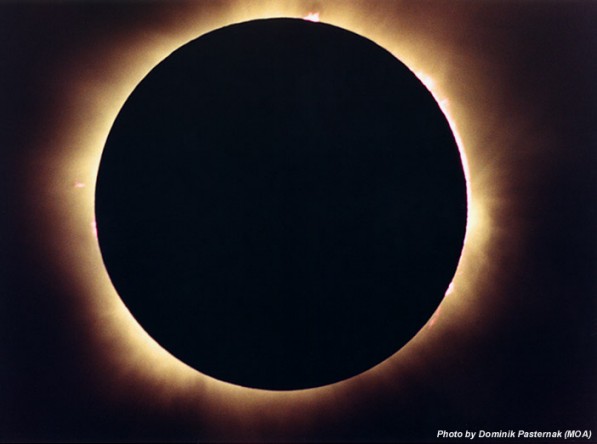Credit & Copyright: Dominik Pasternak
Explanation:
During a total solar eclipse,
Earth's moon blocks the sun -
almost exactly.
While the sun is about 400 times wider than the moon, it is also
about 400 times farther away and each appears to be
half a degree or so in diameter.
On August 11, this remarkable coincidence in the apparent size of two
vastly different celestial bodies produced tantalizing solar
spectacles for denizens of Europe and Asia.
For example, prominences along the sun's limb peer around the
moon's dark edge in
this dramatic picture of totality recorded
as the lunar shadow swept across Hungary.
Subtle structures in the sun's inner corona are also visible
streaming beyond the silhouetted moon.
This total eclipse of the sun was the last to grace planet Earth's
skies for this
millennium.
Although four partial
eclipses will occur in the year 2000, the
next total eclipse will not be until 2001 June 21.
1999 2000 2001 2002 2003 2004 2005 2006 2007 2008 2009 2010 2011 2012 2013 2014 2015 2016 2017 2018 2019 2020 2021 2022 2023 2024 2025 |
Yanvar' Fevral' Mart Aprel' Mai Iyun' Iyul' Avgust Sentyabr' Oktyabr' Noyabr' Dekabr' |
NASA Web Site Statements, Warnings, and Disclaimers
NASA Official: Jay Norris. Specific rights apply.
A service of: LHEA at NASA / GSFC
& Michigan Tech. U.
|
Publikacii s klyuchevymi slovami:
Sun - corona - solar eclipse - Moon - Solnechnoe zatmenie - Solnce - Luna - Solnechnaya korona
Publikacii so slovami: Sun - corona - solar eclipse - Moon - Solnechnoe zatmenie - Solnce - Luna - Solnechnaya korona | |
Sm. takzhe:
Vse publikacii na tu zhe temu >> | |
